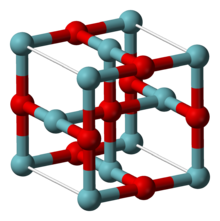 | |
| Names | |
|---|---|
| Other names niobium(II) oxide | |
| Identifiers | |
3D model (JSmol) | |
| ChemSpider | |
| ECHA InfoCard | 100.031.631 |
PubChem CID | |
CompTox Dashboard (EPA) | |
| |
| |
| Properties | |
| NbO | |
| Molar mass | 108.905 g/mol [1] |
| Appearance | grey solid [1] |
| Odor | odorless |
| Density | 7.30 g/cm3 [1] |
| Melting point | 1,937 °C (3,519 °F; 2,210 K) [1] |
| Solubility | slightly soluble in HCl insoluble in nitric acid |
| Structure [2] | |
| Cubic, cP6 | |
| Pm3m, No. 221 | |
a = 0.4211 nm | |
Formula units (Z) | 3 |
| Thermochemistry [3] | |
Heat capacity (C) | 41.3 J/(mol·K) |
Std molar entropy (S⦵298) | 48.1 J/(mol·K) |
Std enthalpy of formation (ΔfH⦵298) | −405.85 kJ/mol |
Gibbs free energy (ΔfG⦵) | −378.6 kJ/mol |
Except where otherwise noted, data are given for materials in their standard state (at 25 °C [77 °F], 100 kPa). | |
Niobium monoxide is the inorganic compound with the formula Nb O. It is a grey solid with metallic conductivity. [1]